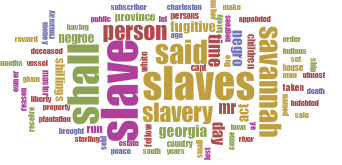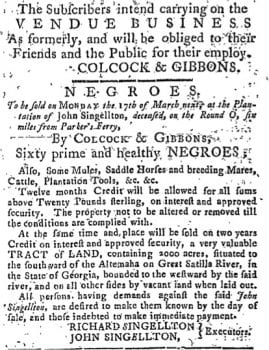By Maury Saitow
Slavery in the period of the American Revolution is commonly thought of as the enslavement of the African peoples. However, those who lived during this time period may not have believed this to be so. Throughout my study of early American newspapers from 1763-1787 I have found that the most common uses of the words “enslavement” and “slave” were used to refer to the white colonists rather than those of African descent, who we traditionally view as slaves. The American people living under British rule considered themselves enslaved under the monarchy; however, the American people did not see the African slaves in the very same situation under slave owners throughout the country.
Through researching the occurrence of certain words in American newspapers from the period of 1763-1787, many interesting details can be found. I looked through newspapers mostly from Georgia, South Carolina, and Massachusetts. I looked into these three places because I wanted to compare the attitudes towards slavery between the Northern and the Southern colonies. I chose Massachusetts because it was one of the oldest colonies, and so I assumed that it would be more heavily populated and as a result, would have more publications throughout the colony than other Northern colonies. I chose to look at South Carolina and Georgia because they were two colonies in the Lower South and definitely had many slave-owning citizens. Prior to my research, I thought that I would find that in South Carolina and Georgia there would be little to no opposition to slavery, and that the Massachusetts publications would have the beginnings of the abolitionist movement. However, this was not the case. I found that “slave” was not only used to refer to African slaves, but to the colonists themselves. I researched more into this subject, and found that at the period before and during the Revolution, African slavery was not really considered a pressing issue in the colonies.

First, I investigated the use of the word “slave.” In my data visualization, a word cloud, “slave” and “slaves” are two of the biggest words. This was expected, as my entire project revolved around slaves. However, I found that the word “slave,” when not used in an advertisement for slave sales, was mostly used in relation to the white colonists and their being oppressed by the British. This does not mean that there was not anti-African slavery sentiment. The beginnings of the abolitionist movement could have been occurring at this time. According to Patricia Bradley, in the years directly preceding the Revolution, there was anti-slavery sentiment in Massachusetts. This sentiment was not published in the Boston Gazette, which is consistent with my findings.[1] In my opinion, this was not published because it would have detracted from the Revolution and the ideas that the editors of the Boston Gazette wanted to put into the minds of their readers.
An interesting point in my data visualization is that the words “person,” “negro,” and “slave” are all large. This is interesting because, particularly in the south, slaves and negroes were not necessarily considered people. However, since the context of the use of “slave” is used toward the white colonists in relation to the British, it is understandable that “person” is so large. The whites considered themselves enslaved peoples to the British, but did not consider the Africans to be enslaved peoples, rather, they were pieces of property.

South-Carolina Weekly Advertiser, February 19, 1783
The main focus of newspaper articles from this time period concerning African slaves were advertisements for the sale of slaves. Slaves were often sold after an owner was deceased. Slaves were sold for next to nothing in today’s standards. However, in colonial America, slaves were a high selling product. A slave was worth more based on the amount of work that he could perform or on the age of the slave, which is seen throughout the advertisements that were published particularly in the Georgia Gazette. Slave auctions were extremely common, especially in the Southern colonies in later years. The slave trade did decrease in the northern colonies in later years, which can be seen through the lack of advertisements for slave sales in northern newspapers. This could be due to the fact that more slaves were needed in the southern colonies because that was where the majority of crop and other natural resource production was. Damian Alan Pargas highlights the notion that slave labor did increase in the South because of increased cotton production. However, many were not purchasing grown slaves from the North because they did not know how to do the hard labor that cotton cultivation involved. So, plantation owners would either purchase slaves who were from the south and knew the hard work, or slaves that were young enough to be shaped into the idea cotton working slave.[2] There is also a likelihood that the slave trade began to decrease in the north because of changing attitudes. This could have been due to religious ideals as well as an attitude based on the need. Religious ideals are a more plausible answer because of the Great Awakening and other such movements. However, at the time, colonists were not as concerned with the plight of the slaves because they were feeling enslaved themselves.
Overall, the word cloud data visualization that came from my research was not consistent with the results that I predicted. The institution of slavery was virtually ignored throughout the colonies at the time of the Revolution. This is due to the fact that the white colonists were more concerned with the fact that they were enslaved under the British. This ironic idea is interesting in that the white colonists believed that the actions of the British were morally wrong, yet the white colonists were doing no wrong against anyone, particularly the African slaves. Through my findings, one can see that for the white American colonists, the word “slave” referred to whites under British oppression rather than those who were enslaved under both the British and the white American colonists, the African slaves.
[1] Patricia Bradley, p.583
[2] Pargas, p.564
For Further Reading:
Bradley, Patricia. 1995. “The Boston Gazette and Slavery as Revolutionary Propaganda.” Journalism & Mass Communication Quarterly 72, no. 3: 581-596.
Pargas, Damian Alan. 2013. “In the Fields of a ‘Strange Land’: Enslaved Newcomers and the Adjustment to Cotton Cultivation in the Antebellum South.” Slavery & Abolition 34, no. 4: 562-578.
Comments are closed.